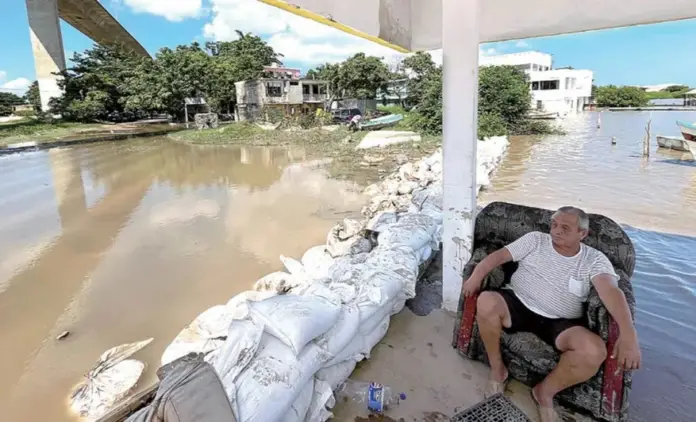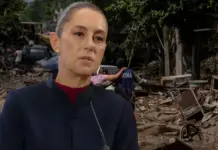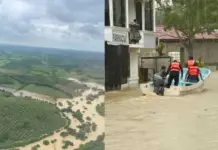Mr. Tomás walks through the mud that has seeped from the sandbanks onto the banks of the Pánuco River, which is rising every day. He goes to see if it’s true that the river’s flow is increasing, because he doesn’t believe it will reach its crest and even says, “They’re just scaring us.”
Just last Thursday night, Mayor Mónica Villarreal, Municipal Civil Protection personnel, and Gerardo González de la Fuente, Tamaulipas Civil Protection Coordinator, went to evaluate the placement of sandbanks in the lowest area, exactly below the Tampico Bridge.
The water from the tributary has already passed through the sandbanks installed for containment, and a small lagoon has formed in the middle of the neighborhood. However, Tomás still maintains, “The way I see it, I don’t believe it. The critical period is over. Now the water is slowly receding, because in fact, we were already flooded, and now we’re flooding less.”
The resident of the so-called “lost city,” where they sleep lulled by the sound of the passing river water, insists that “nothing will happen” despite the fact that the currents coming upstream have already caused flooding, death, and destruction in states such as Veracruz, San Luis Potosí, and Hidalgo.
More than 32,000 people in Tampico are at high risk, distributed across seven neighborhoods, including Tamaulipas, Guadalupe Victoria, El Golfo, Vicente Guerrero, and even downtown Tampico, as authorities have announced.
“I don’t think I’ll experience the flooding like they’re scaring people away,” assures the river resident, confident that the sky in Tampico is clear and that there is no serious flooding affecting residents. The Pánuco River levels are lowering, and they are losing their fear of the rising Pánuco River and clinging to their homes.
Fearlessly challenging nature, the river residents confidently claim to know the river’s flow well from their years living there, in the so-called “lost city.” Below the Tampico Bridge, they refer to the municipality of the same name as the river. At 8 a.m. this Friday, the river was at 7.66 meters, 36 centimeters below the critical level on the hydrometric scale.
However, the amount of water flowing down from the upper reaches of the colossal river—at 3 p.m., it was already 1.71 meters—had already reached 41 centimeters below the critical level, so the amount of water that continues to flow increases all the time.
There is a man standing under a cement roof with the word “Paso Santacruz” written on it. He is standing on an old piece of furniture, looking out toward the river, toward the horizon framed by the brown water of the current and the shadow the river casts.
His name is Juan Antonio Hernández. The man with a serious expression observes and says, “It’s been normal these past few days, just like it is now, calm.”
The water level is rising and there are some puddles, so that reassures the resident of the Guadalupe a Victoria neighborhood. He says that on Thursday night, Civil Protection personnel came to warn them that they would have to leave if the water level rose, and they also placed sand-filled sandbanks, which the water has already submerged.
Mayor Mónica Villarreal Anaya came with State and Municipal Civil Protection to place sandbanks under the Tampico Bridge, the lowest area of the city, to prevent the water from reaching more homes.
“It was only in 1955 (Cyclone Hilda), since then there hasn’t been an emergency,” explains Mr. Lucio López Arana, who is sitting in the shade on one of the pillars of the Tampico Bridge, after observing the river’s current with his own eyes. Mr. Lucio admits he took a trip to the river because he lives near the train tracks, which are approximately three blocks from the river. He states, “You can’t even see the rush of water, nothing, everything seems normal.”
The water has trickled down to southern Tamaulipas, but the alerts remain in effect, as some damage has begun to occur in communal land areas of the municipality of Pánuco—approximately 30, according to official reports.
There are reports of 15 people staying at the shelter in the Moscow neighborhood, at the Center for Well-being and Peace, an area that flooded just this July. It is a point where the Tamesí and Pánuco rivers meet.
Governor Américo Villarreal Anaya conducted an overflight to monitor the rising waters of the Pánuco River and reiterated that the Tamaulipas government is alert and fully prepared to provide all necessary assistance to families in the metropolitan area who require it.
This Friday afternoon, aboard the “Tláloc” plane and accompanied by Raúl Quiroga Álvarez, Secretary of Hydraulic Resources, the Tamaulipas state executive toured the banks of the Pánuco River, reaching the municipality of Tamuín, San Luis Potosí, where he witnessed the impacts on several rural communities due to the river’s overflowing.
In this region, it was observed that the flooded plains are lightening the water load that will reach the southern part of Tamaulipas, as these overflows along the river serve to cushion the impact of the water.
“So far, conditions are warning the population, with no expectations of a catastrophic situation,” said the state leader.
Australian oil company Woodside Energy joined the effort to support those affected by last week’s rains in northern Veracruz and parts of southern Tamaulipas by making a cash donation to the Mexican Red Cross for humanitarian aid.
Executives of the foreign company, which operates in the country while preparing its Trión project in the deep waters of the Gulf of Mexico, contributed approximately 400,000 pesos (approximately US$20,000) in kind to address the first-line needs of thousands of people resulting from the flooding.
“This is a tragic event for the communities of the Huasteca region, and our thoughts are with those affected. We are committed to supporting communities in all regions where we operate,” said Daniel Kalms, Executive Vice President and Director of International Operations.
The donation will be used to provide humanitarian aid, including food, hygiene and cleaning kits, medical support, care packages, and search and rescue operations led by the Mexican Red Cross.
Taking Advantage of the Troubled Waters for Fishing At four in the afternoon, Eduardo Ramírez leaves his house directly to the lagoon in Pueblo Viejo, Veracruz, to set his net and leave it overnight to catch fish and crabs. He will then stock the stalls at the La Puntilla fish and seafood market, located on the banks of the Tamesí River in Tampico, the next day.
Around ten in the morning, he arrives at the spot and is accompanied by his namesake Eduardo on the fiberglass boat. The two begin to untangle the fish caught in the Pueblo Viejo lagoon.
They say that when the waters are rough, fishermen profit. For Eduardo, it’s in the product, but not in sales. Despite the rising waters of the rivers and lagoons in northern Veracruz, fishing has been good, and they managed to catch a good number of species, including sea bream, silver bream, and crabs.
“Fishing has been good, but the worst thing is the sales because they alarm people by saying the water is going to rise and that it’s flooded. The water level is high, but it’s normal, like every year, but they alarm people by saying La Puntilla is flooded, and that affects both us fishermen and the merchants.”
Having dedicated eight years to fishing, the young man says he’s currently working at a stand, but there are few sales. “I’m a fisherman, but right now I’m also working at a stand. There have been few sales for a week now; people aren’t coming to buy.
There’s fishing, but no one is coming to buy.” As he continues to pull fish from the net, he says the rising water has generated more fish, but it’s of little use if there are no sales.

Source: milenio




